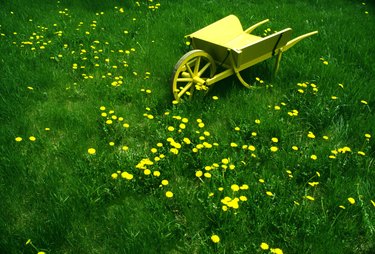
If you're looking to rid your North Carolina lawn of weeds, don't wait until they show up to attack them. A pre-emergent weed killer eliminates weeds before they appear. Summer and winter weeds that plague your lawn can be controlled with the timely application of a pre-emergent. These weed killers don't actually kill; they attack the weed's root development to prevent its appearance above ground. Existing weeds need to be dealt with using a postemergent or a mechanical removal strategy. Paying attention to average dates of the spring warm-up and fall temperature drops in North Carolina helps you plan a strategy to get at weeds before they emerge; extreme western mountain regions and the coast may vary in average pre-emergent application dates from the rest of the state.
Importance of Timing
Video of the Day
Timing is key when applying a pre-emergent weed killer. Pre-emergents form a barrier in the soil so that seedlings cannot pass through to emerge from the ground. The herbicide needs to be applied before the seedlings emerge because pre-emergents will not kill existing weeds. Application of the pre-emergent should be one to four weeks before germination.
Video of the Day
Spring Application
The average time to apply pre-emergent weed killer in most parts of North Carolina is the last two weeks of March. Common summer annual weeds such as crabgrass and dandelions germinate when soil temperatures reach 55 to 60 degrees Fahrenheit. The pre-emergent needs to be applied and watered in by then. Since temperatures can vary quite a bit year to year, even in the same region, a good rule of thumb is to apply your spring pre-emergent when the forsythias in your area bloom. This happens before crabgrass germinates, so you can be sure of timing your application correctly without having to track the soil temperatures in your specific region.
Fall Application
Some weeds that plague a North Carolina lawn grow from seeds that remain dormant through the spring and then germinate when the temperature drops in the fall. Pre-emergent weed killer applied in the fall can kill winter annual weeds common to North Carolina, like chickweed, wild onion, wild mustard, Carolina Geranium and henbit. Apply pre-emergent in mid-August to mid-September to stop these weeds from taking hold through the fall and winter. Because weeds germinate at different times, another application in early December can stop late germinators. If you live in the far western parts of the state, expect temperatures to drop earlier; apply pre-emergent in mid-August. Coastal regions can likely wait until September for temperatures to cool.
Turf Preparation and Follow-Up
Pre-emergent weed killer needs to get into the soil where the weed seeds are, so make sure that the turf is prepared to receive it. Rake and remove leaves and other lawn debris. If you have more than a 1/2-inch layer of thatch on your lawn, dethatch it to allow the herbicide to penetrate. After application, if you do not have at least 1/2 inch of rain within a day or two, water your lawn to further help the pre-emergent to penetrate the soil.
- North Carolina Cooperative Extension: Pre-Emergent Control for Summer Annual Weeds in Lawn and Turf
- North Carolina Cooperative Extension: Fall Pre-Emergent Weed Control
- Colorado State University Extension: Herbicides: Pre-Emergent
- Ohio State University Extension: Annual Grass Weed Control in Home Lawns
- North Carolina Cooperative Extension: Gardening Tips: Pre Emergent Control Of Crabgrass And Other Summer Weeds
- North Carolina Cooperative Extension: Enjoy Taking Risks? Try Predicting Final Frost
- WRAL.com: Central North Carolina Fall Frosts and Freezes